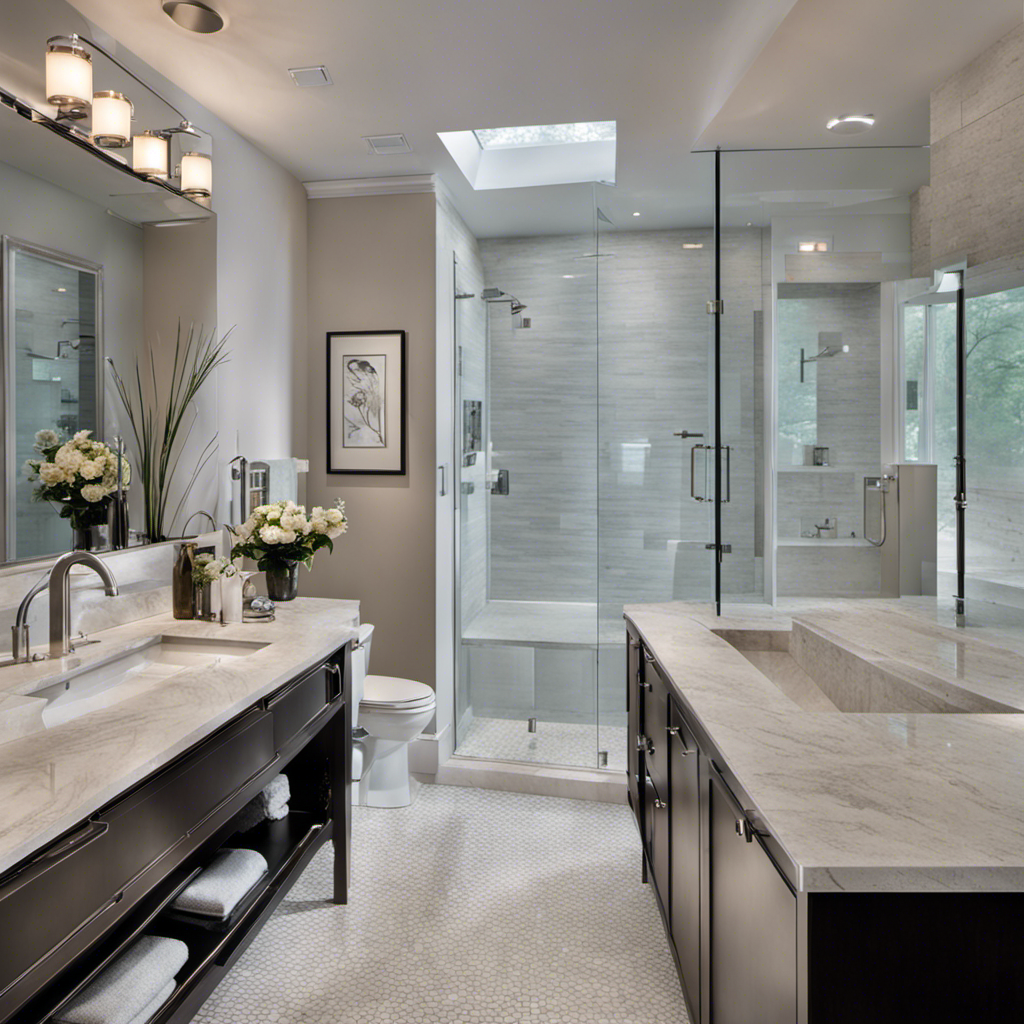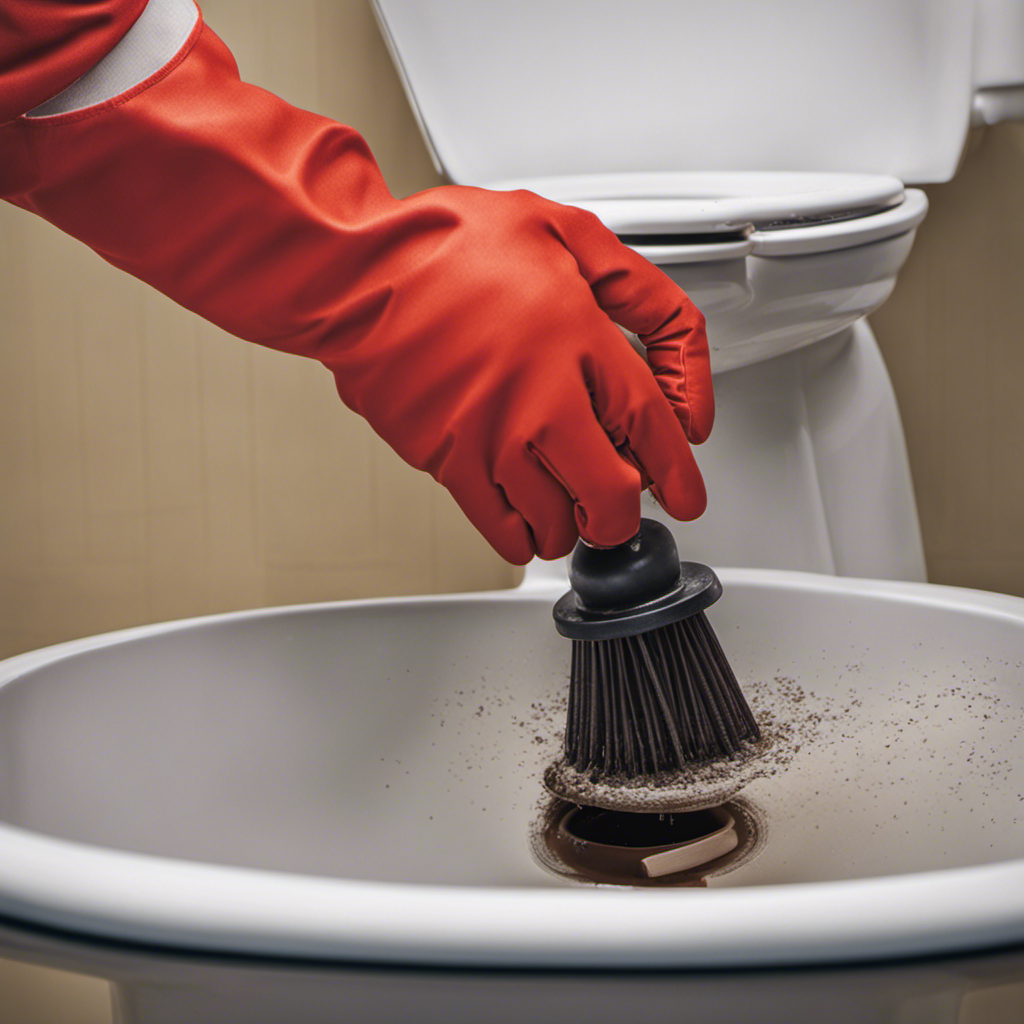Looking to upgrade your bathroom? Discover the practical and cost-effective solution of tub to shower conversion. Say goodbye to your outdated bathtub and hello to a modern, spacious walk-in shower.
This step-by-step guide will show you how to transform your bathroom into a stylish oasis, all while adding value to your property. With DIY methods available, you can achieve this satisfying home upgrade at a lower cost.
Get ready to enjoy the benefits of a tub to shower conversion and create the bathroom of your dreams.
Key Takeaways
- Tub to shower conversion is a practical and cost-effective way to upgrade your bathroom.
- Converting a tub to a shower can make your bathroom look more stylish and spacious.
- DIY tub to shower conversion can be done at a much lower cost than hiring professionals.
- Converting to a shower can give your bathroom a modern and updated look.
Benefits of Tub to Shower Conversion
Converting a tub to a shower enhances the functionality and convenience of the bathroom, making it more accessible for individuals with mobility issues. The benefits of tub to shower conversion are numerous.
First, showers are easier to access, especially for those with limited mobility or physical disabilities. The removal of the tub creates a barrier-free entry, allowing individuals to enter and exit the shower with ease.
Additionally, showers are easier to clean and maintain compared to traditional tubs. They require less water and time to clean, saving both resources and effort.
Moreover, converting a tub to a shower can give your bathroom a modern and updated look. It can make the space feel more open and spacious, creating a more pleasant and enjoyable environment.
Lastly, tub to shower conversion can add value to your property without significant expenses. By modernizing the bathroom, you can increase the overall appeal and marketability of your home.
When considering a tub to shower conversion, there are cost-saving tips to keep in mind. DIY projects can be more affordable than hiring professionals, and selecting shower stall kits can offer a cost-effective solution. Upgrading fixtures and valves during the conversion can provide a modern look without breaking the bank.
Step-by-Step Guide to Tub to Shower Conversion
Removing the bathtub surround is an essential step in the process of transforming a tub into a shower.
When considering a tub to shower conversion, homeowners have the option of choosing between a DIY project or hiring professionals.
DIY tub to shower conversion can be a cost-effective approach, as it eliminates labor costs associated with professional installation. However, it is important to consider the cost breakdown of the project.
The total cost of a tub to shower conversion includes the cost of the shower stall, shower fixtures, shower pan, surround panels, and any necessary plumbing adjustments. Additionally, if homeowners lack the necessary tools and skills, they might need to purchase or rent tools, which should also be factored into the overall cost.
Before deciding on the installation method, homeowners should carefully consider their budget, time constraints, and personal capabilities to ensure a successful tub to shower conversion.
Cost-Effectiveness of Tub to Shower Conversion
Installing a shower stall kit can provide a cost-effective solution for homeowners looking to enhance their bathroom. When it comes to tub to shower conversion, there are various shower stall options available that can fit different budgets and preferences.
Choosing a shower stall kit can help save costs compared to a full bathroom remodel. Homeowners can also consider cost-saving tips such as opting for DIY installation instead of hiring professionals, upgrading fixtures during the conversion, and utilizing existing plumbing if in good condition. These measures can help achieve a modern look without breaking the bank.
Considerations for Tub to Shower Conversion
When considering a tub to shower conversion, homeowners should evaluate the condition of their plumbing and address any necessary repairs or replacements beforehand. Plumbing considerations are crucial to ensure that the new shower functions properly and avoids any potential issues in the future. It is important to check for leaks, corrosion, and the overall condition of the pipes. If there are any plumbing problems, such as low water pressure or faulty valves, these should be fixed before proceeding with the conversion. Additionally, homeowners should also take into account the placement of windows in the bathroom. If the tub is located below a window, it may not be recommended for a shower conversion due to the risk of mold growth and potential damage. It is essential to assess the window placement and consider alternative options if necessary.
| Plumbing Considerations | Window Placement |
|---|---|
| Evaluate plumbing | Assess window |
| Check for leaks | placement in |
| Replace faulty pipes | relation to shower |
| Fix low water pressure | conversion |
| Address valve issues |
DIY Tub to Shower Conversion: A Budget-Friendly Option
A DIY tub to shower conversion can be a cost-effective solution for homeowners looking to modernize their bathroom on a budget. By following a few simple tips, you can save money while transforming your outdated tub into a sleek and functional shower.
First, consider purchasing a shower stall kit, as it provides all the necessary components at a lower cost than buying individual items. Additionally, upgrading fixtures and valves during the conversion can give your bathroom a modern look without breaking the bank.
Another cost-saving option is to complete the conversion yourself rather than hiring professionals, as it can be done with basic tools and DIY skills. With proper planning and execution, a DIY tub to shower conversion can be a rewarding and budget-friendly home improvement project.
Enhancing Functionality: Upgrade Your Bathroom With a Shower
Enhancing the functionality of the bathroom, homeowners can transform their outdated tub into a sleek and functional shower through a DIY tub to shower conversion. This upgrade offers numerous benefits, including the increased accessibility of a walk-in shower.
For individuals with mobility issues, showers provide easier access compared to traditional tubs. Additionally, showers are easier to clean and maintain, making them a more convenient option.
Converting a tub to a shower also opens up space in the bathroom, creating a more open and spacious feel. It also gives the bathroom a modern and updated look, adding value to the property.
When considering a shower conversion, it’s important to evaluate accessibility considerations, such as the presence of windows and the condition of plumbing. With proper planning and execution, a tub to shower conversion can be a satisfying home upgrade that improves daily routines and personal hygiene.
Tub to Shower Conversion: Creating a Modern Bathroom
Installing a sleek and functional walk-in shower can create a modern and updated look in the bathroom. When considering a tub to shower conversion, it’s important to choose the right fixtures and address any plumbing issues.
The right fixtures can enhance the functionality and aesthetic appeal of the shower. Opt for fixtures that are durable, easy to clean, and complement the overall style of your bathroom.
Additionally, when dealing with plumbing issues, it’s crucial to evaluate the condition of existing plumbing and make any necessary repairs or upgrades. This may include replacing outdated pipes, valves, or drains to ensure proper water flow and prevent any potential leaks or clogs.
Increase Property Value With a Tub to Shower Conversion
Converting a bathtub into a walk-in shower can significantly increase the value of a property. By improving accessibility and modernizing the bathroom, this conversion appeals to a wider range of potential buyers.
Increasing home value is achieved through the addition of a highly functional and stylish shower. Not only does it make the bathroom more accessible for individuals with mobility issues, but it also provides a more convenient and enjoyable bathing experience for everyone.
The cost-effectiveness of this upgrade is another attractive factor, as it can be done at a lower cost compared to a full bathroom remodel. With proper planning and execution, the tub to shower conversion can be completed within a reasonable timeframe, resulting in higher satisfaction with the outcome.
The Satisfaction of a Tub to Shower Conversion
The transformation from a bathtub to a walk-in shower brings a sense of satisfaction and enjoyment to homeowners. Here are four reasons why:
-
Personal experiences with tub to shower conversions: Many homeowners who have undergone this conversion have expressed their satisfaction with the outcome. They appreciate the convenience and functionality of a walk-in shower.
-
Comparing different shower stall options for the conversion: Homeowners have the opportunity to choose from a variety of shower stall options, such as corner showers, neo-angle showers, or alcove showers. This allows them to customize their shower to fit their bathroom layout and personal preferences.
-
Enhanced accessibility: For individuals with mobility issues or aging in place concerns, a walk-in shower offers easier access compared to a bathtub. This increases safety and independence in the bathroom.
-
Modern and updated look: Converting a tub to a shower can give a bathroom a fresh and modern appearance. Homeowners can choose from a wide range of stylish shower fixtures and finishes to create their desired aesthetic.
Overall, the satisfaction of a tub to shower conversion lies in the improved functionality, accessibility, and aesthetics that it brings to a bathroom.
Transform Your Bathroom: Tub to Shower Conversion Explained
Homeowners can achieve a modern and functional bathroom by transforming their bathtub into a walk-in shower. This tub to shower conversion offers numerous benefits, including increased accessibility, easier maintenance, and a more updated look. However, it’s important to consider the pros and cons before undertaking this project.
To help you make an informed decision, here are some of the best shower stall options to consider:
| Shower Stall Option | Pros | Cons |
|---|---|---|
| Acrylic Shower Stall | – Affordable |
- Easy to clean
- Wide range of styles and sizes | – Less durable compared to other materials |
| Fiberglass Shower Stall | – Lightweight - Easy to install
- Cost-effective | – Prone to scratches and chips |
| Tile Shower Stall | – Customizable - Stylish
- Durable | – Requires more maintenance
- Higher installation cost |
Each option has its own advantages and drawbacks, so it’s important to choose the one that best suits your needs and budget. Consulting with a professional can also help ensure a successful tub to shower conversion.
Frequently Asked Questions
How Long Does a Tub to Shower Conversion Typically Take?
A tub to shower conversion typically takes around 1-2 weeks, depending on the complexity of the project. Factors such as plumbing adjustments and tile installation can affect the duration. Hiring professionals can ensure a timely and efficient completion.
Can a Tub to Shower Conversion Be Done in a Small Bathroom?
Yes, a tub to shower conversion can be done in a small bathroom. It presents challenges in terms of space, but with a space-saving design and careful planning, it is possible to achieve a functional and stylish shower area.
What Materials Are Commonly Used for Shower Pan Installation?
Shower pan installation techniques involve using various materials such as fiberglass, acrylic, or tile. These materials provide durability and water resistance. Proper installation ensures a sturdy base for the shower and prevents leaks.
Are There Any Specific Maintenance Requirements for a Shower After the Conversion?
After a tub to shower conversion, regular maintenance is necessary. To keep the shower clean, use mild cleaning products and a soft cloth or sponge. Regularly check and repair any leaks or damaged caulking to prevent water damage.
Can a Tub to Shower Conversion Be Reversed if Desired in the Future?
Yes, a tub to shower conversion can be reversed if desired in the future. The process would involve removing the shower fixtures and reinstalling a bathtub. However, it is important to consider the specific layout and plumbing requirements of the bathroom.
Conclusion
In conclusion, tub to shower conversion is a practical and cost-effective way to upgrade your bathroom. By following a step-by-step guide, homeowners can easily transform their outdated tub into a modern and spacious walk-in shower.
This DIY project not only adds value to the property but also offers a satisfying home upgrade experience. So why settle for a cramped and outdated bathroom when you can create a stylish and functional space?
Isn’t it time to make the change and enjoy the luxury of a tub to shower conversion?










